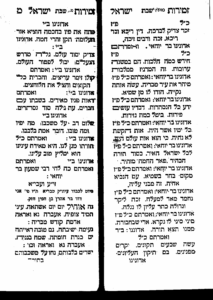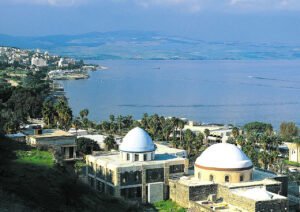ֹ
A piyyut of the 18th century by R. David Ḥassin, one of the greatest composers of Morocco. In this piyyut, dedicated to the city of Tiberias and recounting its praises, we tour Tiberias and the graves of the tannaim and amoraim there, and come to the place of Maimonides’ burial according to tradition. From the dead, the composer moves on to tell the prose of the living – R. Ḥayyim Abulˁafia, who renewed Jewish settlement in Tiberias to where he had moved with his students in the year 5500 [1740], doing much to revitalize the Jewish settlement and build the city, for which R. David Ḥassin praises and blesses him at the conclusion of the poem. This poem was very beloved and merited widespread circulation, and is found in poetry books of many different Mizraḥi communities. This poem has also merited a number of imitations and adaptations, testifying to its great popularity. The most well-known imitation is a poem by the Israeli diaspora-emissary R. Eliyahu Ḥazzan, who arrived at Morocco, came across this song, and composed an imitation, also called “As Every Day I Hope” — except R. Eliyahu Ḥazzan’s song is dedicated to Jerusalem and tours around it.[1] An English translation of the note from the NLI piyyuṭ website
I’ve transcribed and translated this poem in honor of the Purim Qatan of Tiberias, coming up on the seventh of Elul. But for many communities it would be recited regularly as part of the zemirot for Havdalah. Attached is a scan of the page where it appears within the diwan of Shimon Shabazi.
Note: “The CAUSE” is used to translate the Divine Name YHVH, based on the philosophical idea of God as the Prime Mover and on the interpretation of the Name as a causative form of the copula – “causes to be.” “God” is used to translate the divine name Elohim. All divine referents (pronouns, epithets, names) are rendered in unicase.
| Source (Hebrew) | Translation (English) |
|---|---|
אוֹחִיל יוֹם יוֹם אֶשְׁתָּאֶה תָּמִיד עֵינִי צוֹפִיָּה אֶעְבְּרָה־נָא וְאֶרְאֶה אַדְמַת קֹֽדֶשׁ טִבֶּרְיָה׃ |
As every day I hope, wondering, my eye always gazing — Let me go over and see the holy land, Tiberias! |
נָעֲמָה[2] נ״א נְעִימָה יְשִׁיבָתָהּ גַּם טוֹבָה רְאִיָּתָהּ יָם כִּנֶּֽרֶת חוֹמָתָהּ שָֽׁמָּה הָעִיר בְּנוּיָה׃ אֶעְבְּרָה־נָא… |
Nice its settlement, so too good is its sight; the Sea of Galilee its wall, there the city is built. Let me go over… |
יְשָׁרִים בְּלִבּוֹתָם נָֽחוּ עַל־מִשְׁכְּבוֹתָם בְּתוֹכָהּ קְבוּרָתָם כֻּלָּם בְּנֵי עֲלִיָּה׃ אֶעְבְּרָה־נָא… |
Inside it the burials of the righteous-hearted, who rest in eternal sleep; all lofty people. Let me go over… |
דֶּֽרֶךְ הָהָר יִתְבּוֹנָן קֶֽבֶר רַבָּן יוֹחָנָן בֵּן־זַכַּאי שָׁם יִתְלוֹנָן יָחִיד בְּדוֹרוֹ הָיָה׃ אֶעְבְּרָה־נָא… |
DAre gaze toward the mountain, the grave of our rabbi Yoḥanan ben Zakkai, lying there, unique in his generation. Let me go over… |
וַחֲמִשָּׁה תַּלְמִידִים צַדִּיקִים וַחֲסִידִים מִזָּהָב נֶחֱמָדִים[3] יש שהופכים את הפסוקיות המתחילות בצַדִּיקִים ובמִזָּהָב מוֹנֶה שְׁבָחָן הָיָה׃ אֶעְבְּרָה־נָא… | |
דִּמָּה אֶחָד לְבוֹר סִיד טִפָּה אַחַת לֹא יַפְסִיד וְלַחֲבֵרוֹ קָרָא חָסִיד וְחַד דְּחִיל חוֹבַֽיָּא׃ אֶעְבְּרָה־נָא… | |
בָּם חָכָם בְּעֹז גִּבֵּר כַּמַּעְיָן הַמִּתְגַּבֵּר אַשְׁרֵי יָלְדָה עַל־מַשְׁבֵּר אֶת־בְּנוֹ שֶׁל־חֲנַנְיָה׃ אֶעְבְּרָה־נָא… | |
רֹאשׁ הָהָר שָׁם מַצֵּבָה קֶֽבֶר רַבִּי עֲקִיבָא עִמּוֹ עֶשְׂרִים וְאַרְבָּעָה אֶֽלֶף תַּלְמִידַֽיָּא[11] נ״א תַּלְמִידָא ׃ אֶעְבְּרָה־נָא… |
ARranged at the top of the hill is a pillar, the grave of Rabbi ˁAqiva, with whom were twenty-four thousand students. Let me go over… |
אַשְׁרֵי הַשָּׂם רַעְיוֹנָיו לִרְאוֹת שָׁם נֶֽגֶד פָּנָיו[12] נ״א יָשִׁית שָׁם לְנֶֽגֶד עֵינָיו רַבִּי חִֽיָּא וּבָנָיו יְהוּדָה וְחִזְקִיָּה׃ אֶעְבְּרָה־נָא… |
Anyone who sets his mind to see there the faces[13] Some texts read “to be set there, in the sight” of Rabbi Ḥiyya and his schildren Yehuda and Ḥizqiyya is content. Let me go over… |
הַר גָּבֽוֹהַּ וְרָם עַל הוּקַם עָלָיו מִמַּעַל רַבִּי מֵאִיר הוּא בַּֽעַל אָתַֽיָּא וְתִמְהַֽיָּא׃ אֶעְבְּרָה־נָא… |
High atop a high mountain, raised above all, R. Meir, who is the master of signs and wonders. Let me go over… |
רַבִּי יוֹחָנָן חָנָה שָׁם יַֽחַד עִם־רַב הוּנָא וְעִמָּהֶם רַב כָּהֲנָא וְגַם רַבִּי יִרְמִיָּה׃ אֶעְבְּרָה־נָא… |
Rabbi Yoḥanan encamped there together with Rav Huna, and with them Rav Kahana, as well as Rabbi Yirmiya. Let me go over… |
נִקְבַּר בְּתוֹכָהּ טָמוּן רַבִּי מֹשֶׁה בַּר־מַיְמוֹן הוּא מְפָרֵשׁ דַּת אָמוֹן וְרַב עַל כׇּל־חַכִּימַֽיָּא׃ אֶעְבְּרָה־נָא… |
ON it is concealed the grave of Rabbi Moshe bar Maimon,[14] Maimonides, the RaMBa”M. an interpreter of the true faith, a rabbi over all sages. Let me go over… |
But remember for good the rabbi, our master rabbi, the tree of life, the general, from the family Abulˁafia.[17] Rabbi Ḥayyim Abulˁafia (1660—1744), whose main work was called the Etz Ḥayyim = Tree of Life. Rabbi Ḥayyim Abulˁafia refounded the Jewish community of Tiberias in 1740, and the next few stanzas of the poem are in his praise. Let me go over… | |
ARrayed on his head a holy crown; gentiles[21] Some texts read “a crown of the Deity; the people” seek him out; from his mouth Torah is saught, from morning until evening. Let me go over… | |
ḤASSIN — Mighty one of Yah whom none is like, a holy man of God, in whose mouth’s exhalations are firestorms, divine flame.[24] Song of Songs 8:6 Let me go over… | |
חִדֵּשׁ הָעִיר שִׁכְלְלָהּ חוֹמָתָהּ וְגַם חֵילָהּ בֵּית מִדְרָשׁוֹ כִּלְכְּלָהּ כׇּל־יָמָיו אֲשֶׁר[25] יש מדלגין על אֲשֶׁר הָיָה׃ אֶעְבְּרָה־נָא… |
STRaightening out and renewing the city, its walls and its force, he sustained its study-hall all his days. Let me go over… |
זַרְעוֹ לְעוֹלָם יִחְיֶה בְּקִנְיַן[26] נ״א כְּקִנְיַן הַגּוּף יִהְיֶה בִּרְכַּת הֶדְיוֹט אַל־תִּהְיֶה קַלָּה וְגַם־בְּזוּיָה׃ אֶעְבְּרָה־נָא… |
ONto eternity will his seed live, in his own acquisition.[27] Members of the Abulˁafia family live in Tiberias to this day. Some texts read “like item-ownership it should be,” a technical term found throughout the Gemara. Let a commoner’s blessing not be taken lightly or ignored![28] Find Bavli Berakhot 7a — לֹא תְּהֵא בִּרְכַּת הֶדְיוֹט קַלָּה בְּעֵינֶֽיךָ. “The blessing of a commoner should not be light in your eyes.” Let me go over… |
קוֹל זִמְרַת רְנָנַי אִמְרֵי פִי וְהֶגְיוֹנַי יִהְיוּ לִפְנֵי יְהֹוָה כְּמוֹ סֹֽלֶת נְקִיָּה׃ אֶעְבְּרָה־נָא… |
Grant that the sound of my cheering hymns, the words and meditations of my mouth, be before the Cause like pure semolina. Let me go over… |
Source(s)
Notes
| 1 | An English translation of the note from the NLI piyyuṭ website |
|---|---|
| 2 | נ״א נְעִימָה |
| 3 | יש שהופכים את הפסוקיות המתחילות בצַדִּיקִים ובמִזָּהָב |
| 4 | Some inverse the clauses beginning with righteous and more precious |
| 5 | The next few verses are based on Avot 2:8. |
| 6 | Rabbi Eliˁezer ben Hyrcanus |
| 7 | Rabbi Yosi the Priest |
| 8 | Rabbi Shimˁon ben Netanel |
| 9 | Rabbi Elˁazar ben ˁArakh |
| 10 | Rabbi Yehoshuaˁ ben Ḥananya |
| 11 | נ״א תַּלְמִידָא |
| 12 | נ״א יָשִׁית שָׁם לְנֶֽגֶד עֵינָיו |
| 13 | Some texts read “to be set there, in the sight” |
| 14 | Maimonides, the RaMBa”M. |
| 15 | יש מוסיפין מַר |
| 16 | יש מחלקין את השם לאַבּוּ אֶל־עַפְיָא |
| 17 | Rabbi Ḥayyim Abulˁafia (1660—1744), whose main work was called the Etz Ḥayyim = Tree of Life. Rabbi Ḥayyim Abulˁafia refounded the Jewish community of Tiberias in 1740, and the next few stanzas of the poem are in his praise. |
| 18 | נ״א הָאֵל |
| 19 | נ״א הָעָם |
| 20 | יש הופכים את התיבות לתּוֹרָה מִפִּיו |
| 21 | Some texts read “a crown of the Deity; the people” |
| 22 | נ״א אִמְרֵי |
| 23 | לרוב נכתב שַׁלְהֶבֶת יָהּ, אבל בפסוק המקורי משיר השירים נכתב בתיבה אחת. |
| 24 | Song of Songs 8:6 |
| 25 | יש מדלגין על אֲשֶׁר |
| 26 | נ״א כְּקִנְיַן |
| 27 | Members of the Abulˁafia family live in Tiberias to this day. Some texts read “like item-ownership it should be,” a technical term found throughout the Gemara. |
| 28 | Find Bavli Berakhot 7a — לֹא תְּהֵא בִּרְכַּת הֶדְיוֹט קַלָּה בְּעֵינֶֽיךָ. “The blessing of a commoner should not be light in your eyes.” |

“אוֹחִיל יוֹם יוֹם | Oḥil Yom Yom (As Every Day I Hope) — a poem to honor the holy city of Tiberias by David bar Aharon ben Ḥassin” is shared through the Open Siddur Project with a Creative Commons Attribution-ShareAlike 4.0 International copyleft license.











Leave a Reply